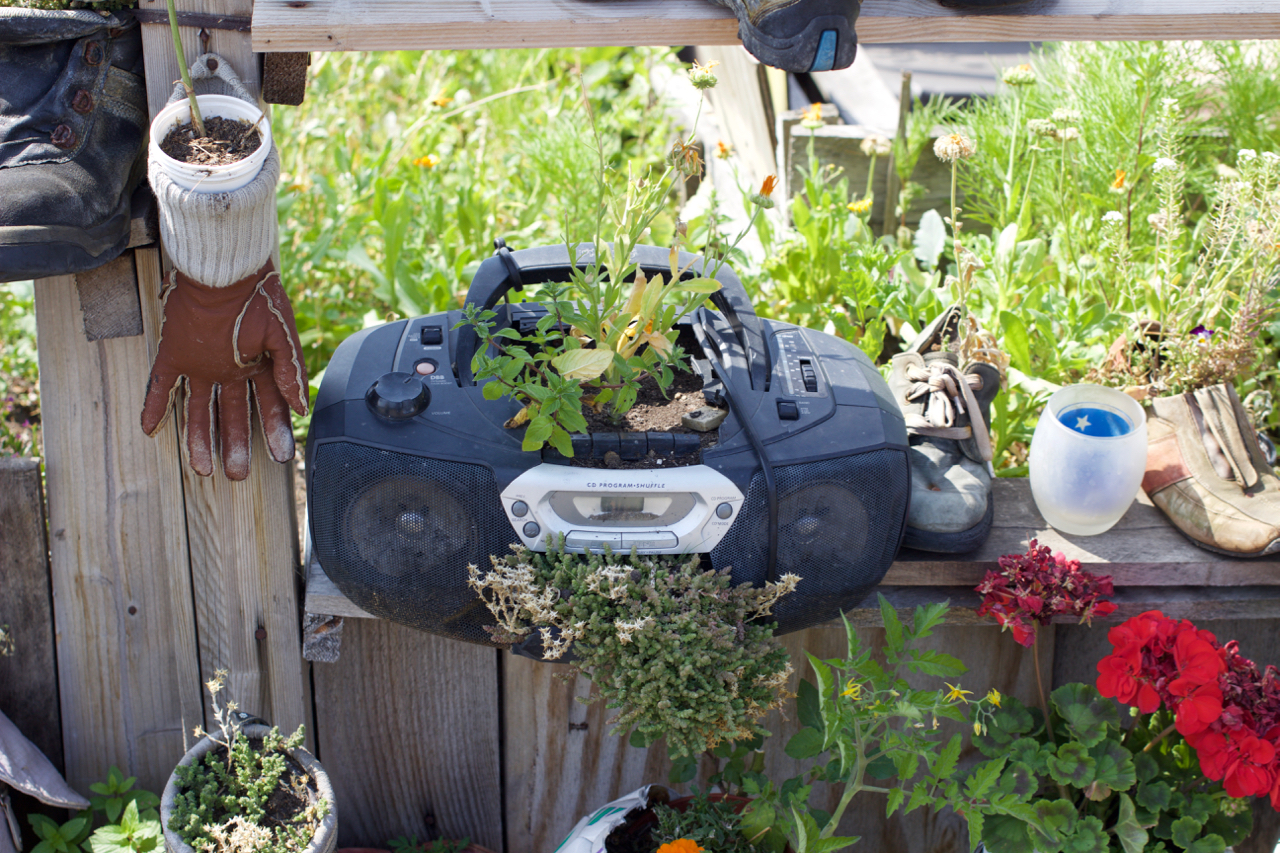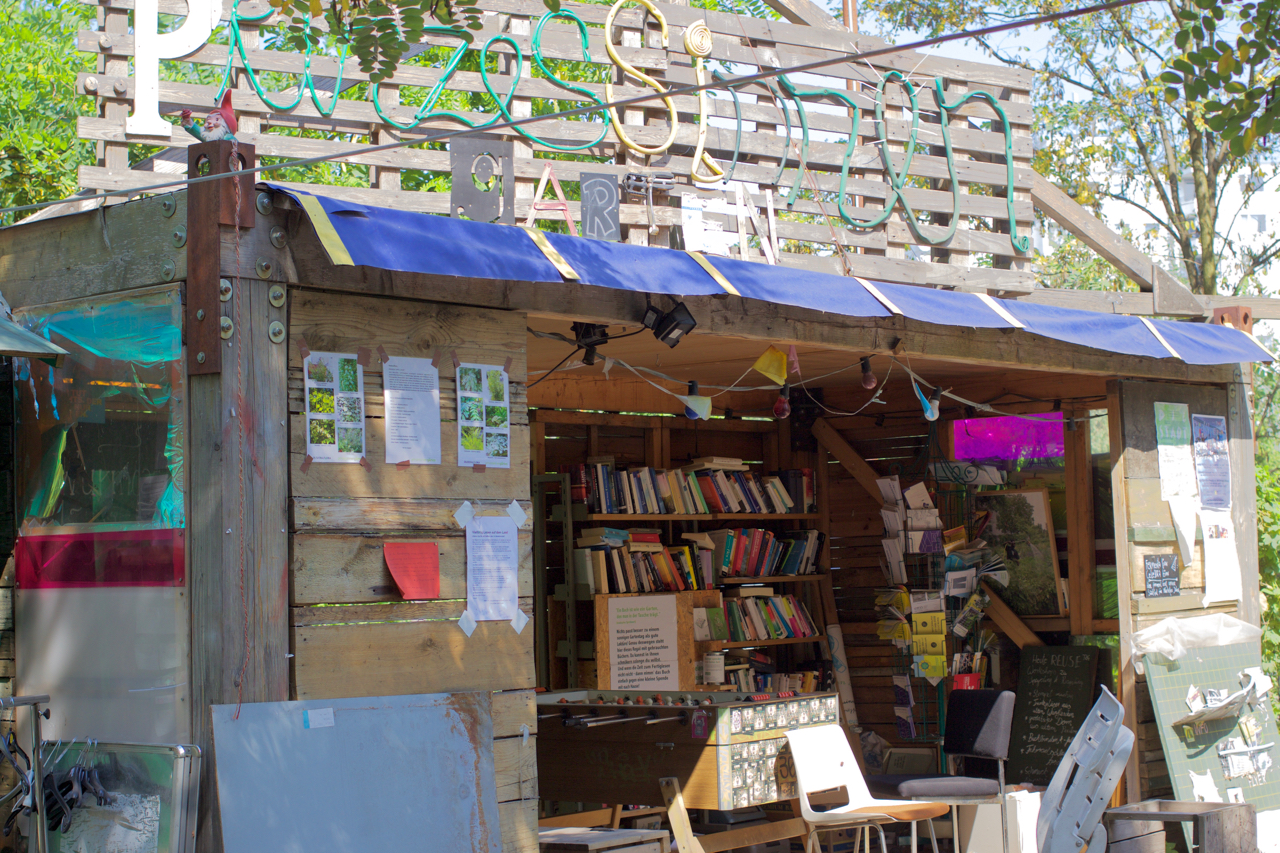 Allmende Kontor at the Templehof airport in Berlin
Allmende Kontor at the Templehof airport in Berlin
Once the center of the global automotive industry, Detroit has become the archetype of the modern ruin, attracting artists and writers interested in exploring the poetics of ruins and the dystopian sublime. The ruins of Detroit are, in one sense, a critique of modernity – an allegory for the myth of unending accumulation, prosperity and progress (Benjamin, 2000). But the post-industrial city is also a place of possibility. Tim Edensor (2005) argues that ruins constitute subversive counter-spaces that “contain the promise of the unexpected” (p. 4). In post-2008 Detroit this promise bloomed in abandoned lots throughout the city as residents began producing their own food outside the circuits of the local state.
But how unexpected was this sudden turn to urban food growing? As Laura Lawson (2005) reminds us, urban food production and economic crisis have long gone hand in hand, and this history has deep roots in Detroit. During the depression of 1893, Mayor Hazen Pingree famously implemented the potato patch plan. Faced with economic upheaval and mass unemployment, Pingree encouraged the residents of Detroit to farm vacant lots to feed the city, setting an example that was copied and adapted across the US and Canada.
 The Heidelberg Project, Detroit (Photo – John Granzow)
The Heidelberg Project, Detroit (Photo – John Granzow)
Nathan McClintock (2010) argues that the most recent rise in urban agriculture, both in Detroit and across the globe, should come as no surprise: “As we find ourselves once again in the throes of a crisis of capitalism, the popularity of UA…has surged and the discourse surrounding it has shifted from one of recreation and leisure to one of urban sustainability and economic resilience” (p. 1). While the expansion of urban agriculture often coincides with economic decline, we should resist limiting our understanding of this phenomenon to a crisis narrative. As Sarah Moore (2006) notes, conceiving of urban agriculture as a temporary and limited response to crisis works to uphold an urban normative whereby dominant socio-spatial practices are maintained and reproduced.
Rethinking the relationship between crisis and urban agriculture means looking beyond food outputs and discourses of food security. While assessing the quantity of food produced by urban farms and gardens is important, there is, as Tomkins (2014) puts it, “a need to move beyond the notion that the objective or objects of harvest alone can represent practice” (p. 13). More than sites of food growing, urban gardens and farms reconfigure relationships between people, food and urban space. Conceptualizing urban agriculture as a socio-spatial phenomenon, or social spatialisation (Shields, 1991), allows us to read it as a political and contested landscape in the making. One of the focuses of my current research is the ways in which urban agriculture intersects with ideas and practices around private property and public space in the city.
 Prinzessinnengarten in Kreuzberg, Berlin
Prinzessinnengarten in Kreuzberg, Berlin
Urban agriculture has, in some cases, constituted a re-imagining social relations through the commoning of city spaces. The idea of the commons, so long associated with the left, has been taken up by an increasing number of politicians, planners and economists (Federici, 2010). Sylvia Federici (2010) worries that these recent appropriations might obscure the meaning of the commons and undermine its political value by situating it within the logic of the market. Among the many “commoning activities” emerging as alternatives to the neoliberal city, Federici identifies urban gardens as particularly important:
“their significance cannot be overestimated. Urban gardens have opened the way to a ‘rurbanization’ that is indispensible if we are to gain control over our food production, regenerate our environment and provide for our subsistence. The gardens are far more than a source of food security: They are centers of sociality, knowledge production, and cultural and intergenerational exchange” (p. 3-4).
While urban agriculture initiatives are often colloquially identified as forms of collective urban practice, there is little academic work exploring urban agriculture in relation to the idea of the commons. As Nicholas Blomley (2008) notes, “given the hegemony of certain models of property, the urban commons has often been overlooked and ignored” (p. 311). Questions emerge regarding the relationship between the practice of urban agriculture and its potential for re-thinking land and property regulations in the city intermesh with questions of public space and the right to the city more generally.
The landscape of urban agriculture extends beyond the fences of community gardens and backyard chicken coops and bee hives to entangle an increasing assortment of places and spaces – local and global; public and private; real and imagined. In recent years, cities have increasingly taken steps to integrate urban agriculture into strategic models and visions of the city. My home city of Edmonton, for example, has incorporated a food and agricultural strategy into its municipal development plan, amended local bylaws, and created new urban agriculture land use designations.
 Prairie Urban Farm at the University of Alberta, Edmonton
Prairie Urban Farm at the University of Alberta, Edmonton
Urban agriculture holds an ambivalent space in my mind. It is, on the one hand, a positive thing, but one of relatively minor significance, akin to recycling or carpooling. On the other hand, it seems to hold a decidedly more radical potential, representing a departure from hegemonic corporate-driven food systems, re-connecting people to their food, and opening up political space for new kinds of urban imaginaries and practices. McClintock (2014) reports on how different literatures have portrayed urban agriculture as variously contributing to radical and neoliberal political projects. While some see urban agriculture as part of an emancipatory politics, others have framed certain manifestations of it as a symptom of a deteriorating social safety net and complicit in roll-out neoliberalism (see Pudup, 2008). With McClintock, I accept the complexity and contradictory character of urban agriculture practice across different contexts, emphasizing the need for a cross-case analysis of the production of urban agriculture through an analysis of specific projects.
Michael Granzow is a PhD Candidate in the Department of Sociology at the University of Alberta. He is interested in cities and public space, and is currently studying the urbanization of agriculture in Edmonton, Detroit and Berlin. You can reach Michael by e-mail at granzow@ualberta.ca
References
Benjamin, W. (2000). The Arcades Project. Cambridge: Harvard University Press.
Blomley, N. (2008). Enclosure, common right and the property of the poor. Social & Legal Studies, 17(3), 311-331.
Edensor, T. (2005). Industrial ruins: Spaces, aesthetics and materiality. Oxford: Berg.
Federici, S. (2010). Feminism and the politics of the commons in an era of primitive accumulation. In C. Hughes, S. Peace, & K. V. Meter (Eds.), Uses of a worldwind, movement, movements, and contemporary radical currents in the United States (pp. 283-294). Edinburgh: AK Press.
Lawson, L. J. (2005). City bountiful: A century of community gardening in America. Berkeley: University of California Press.
McClintock, N. (2010). Why farm the city? Theorizing urban agriculture through a lens of metabolic rift. Cambridge Journal of Regions, Economy and Society, 3(2), 191-207.
McClintock, N. (2014). Radical, reformist, and garden-variety neoliberal: Coming to terms with urban agriculture’s contradictions. The International Journal of Justice and Sustainability, 19(2), 147-171.
Moore, S. (2006). Forgotten roots of the green city: Subsistence gardening in Columbus, Ohio, 1900-1940. Urban Geography, 27(2), 174-192.
Pudup, M. B. (2008). It takes a garden: Cultivating citizen-subjects in organized garden projects. Geoforum, 39(3), 1228-1240.
Shields, R. (1991). Places on the margin: Alternative geographies of modernity. New York: Routledge.
Tomkins, M. (2014). Making space for food: Everyday community food gardening and its contribution to urban agriculture. (Doctor of Philosophy), University of Brighton. Retrieved from http://eprints.brighton.ac.uk/12919/1/Mikey%20Tomkins.pdf